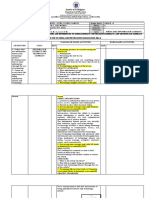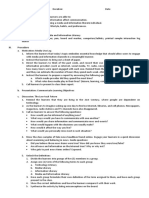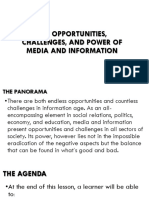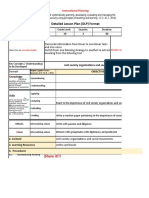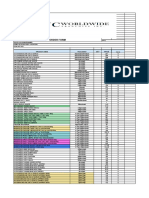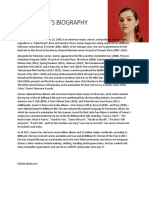0 ratings0% found this document useful (0 votes)
121 viewsAn Introduction To Mil: Maria Lourdes G. Coronacion LSHS Teacher SY 2018-2019
An Introduction To Mil: Maria Lourdes G. Coronacion LSHS Teacher SY 2018-2019
Uploaded by
petor fiegelThis document provides an introduction to media and information literacy (MIL) for students. It begins by outlining the learning competencies and objectives, which include creating a log of media use and defining key concepts. It then describes an activity where students audit their own media consumption and time spent on different media types. Finally, it defines terms related to MIL like media, information, media literacy, information literacy and technology literacy. The document emphasizes that MIL allows people to access, understand, critically evaluate and create various forms of media and information.
Copyright:
© All Rights Reserved
Available Formats
Download as PPTX, PDF, TXT or read online from Scribd
An Introduction To Mil: Maria Lourdes G. Coronacion LSHS Teacher SY 2018-2019
An Introduction To Mil: Maria Lourdes G. Coronacion LSHS Teacher SY 2018-2019
Uploaded by
petor fiegel0 ratings0% found this document useful (0 votes)
121 views28 pagesThis document provides an introduction to media and information literacy (MIL) for students. It begins by outlining the learning competencies and objectives, which include creating a log of media use and defining key concepts. It then describes an activity where students audit their own media consumption and time spent on different media types. Finally, it defines terms related to MIL like media, information, media literacy, information literacy and technology literacy. The document emphasizes that MIL allows people to access, understand, critically evaluate and create various forms of media and information.
Original Description:
Mil
Original Title
Mil Resources1
Copyright
© © All Rights Reserved
Available Formats
PPTX, PDF, TXT or read online from Scribd
Share this document
Did you find this document useful?
Is this content inappropriate?
This document provides an introduction to media and information literacy (MIL) for students. It begins by outlining the learning competencies and objectives, which include creating a log of media use and defining key concepts. It then describes an activity where students audit their own media consumption and time spent on different media types. Finally, it defines terms related to MIL like media, information, media literacy, information literacy and technology literacy. The document emphasizes that MIL allows people to access, understand, critically evaluate and create various forms of media and information.
Copyright:
© All Rights Reserved
Available Formats
Download as PPTX, PDF, TXT or read online from Scribd
Download as pptx, pdf, or txt
0 ratings0% found this document useful (0 votes)
121 views28 pagesAn Introduction To Mil: Maria Lourdes G. Coronacion LSHS Teacher SY 2018-2019
An Introduction To Mil: Maria Lourdes G. Coronacion LSHS Teacher SY 2018-2019
Uploaded by
petor fiegelThis document provides an introduction to media and information literacy (MIL) for students. It begins by outlining the learning competencies and objectives, which include creating a log of media use and defining key concepts. It then describes an activity where students audit their own media consumption and time spent on different media types. Finally, it defines terms related to MIL like media, information, media literacy, information literacy and technology literacy. The document emphasizes that MIL allows people to access, understand, critically evaluate and create various forms of media and information.
Copyright:
© All Rights Reserved
Available Formats
Download as PPTX, PDF, TXT or read online from Scribd
Download as pptx, pdf, or txt
You are on page 1of 28
AN INTRODUCTION TO MIL
MARIA LOURDES G. CORONACION
LSHS Teacher
SY 2018-2019
LEARNING COMPETENCIES
1. describes how communication is affected by media and
information (MIL11/12IMIL-IIIa-1)
2. identifies the similarities and differences of media literacy,
information literacy, and technology literacy (MIL11/12IMIL-IIIa-2)
SPECIFIC LEARNING OBJECTIVES
A. Create a log that reflects current use and interaction with media and
information;
B. Define the key concepts like media, information, technology and
media literacy, information literacy, digital literacy.
THINKING CAPS ON! Recall
Extracted lesson from Oral Communication in Context-Grade 11
ACTIVITY 1: MY MEDIA CONSUMPTION
AUDIT
PROCEDURES
1. Discuss with your group the media type or information providers
and the estimated length of time you engage yourself in this type
of media.
2. Record your output in a manila paper following the given format
found in the STUDENT ACTIVITY SHEET.
3. Report your group output to the class with focus on the following:
Which media provider did you spend the most time?
What role does media play in your lives? (leisure, learning,
communication, entertainment, etc.)
WHAT IS THE ROLE OF MEDIA IN COMMUNICATION?
PRE-VIEWING QUESTIONS
1.What are the components of Media and Information
Literacy?
2.What is Media Literacy?
3.What is Information Literacy?
4.What is Technology Literacy?
5.What is Media and Information Literacy?
1.What are the components of Media and Information
Literacy?
2.What is Media Literacy?
3.What is Information Literacy?
4.What is Technology Literacy?
5.What is Media and Information Literacy?
BASIC COMPONENTS OF MEDIA AND INFORMATION LITERACY
Media and Information Literacy
Media and Information Literacy recognizes the primary role of
information and media in our everyday lives. It lies at the core of
freedom of expression and information - since it empowers citizens to
understand the functions of media and other information providers,
to critically evaluate their content, and to make informed decisions as
users and producers of information and media content.
Media and Information Literacy
Media and Information will enable us to access, understand and create
information and communicate them in various formats.
Accessing Media and Information- the use, navigate, manage, store
and retrieve content in a variety of formats.
Understanding Media and Information – ability to read, construct and
deconstruct , evaluate media contents. A critique view on quality of
material being shared.
Producing Media and Information - ability to produce or create,
publish and distribute ideas and information. Be able to use media
responsibly and to contribute in a democratic process.
SUMMARY OF TERMS DEFINED
• Literacy: The ability to identify, understand, interpret, create,
communicate and compute, using printed and written materials
associated with varying contexts. Literacy involves a continuum of
learning, wherein individuals are able to achieve their goals, develop
their knowledge and potential, and participate fully in their
community and wider society.
• Media: The physical objects used to communicate with, or the mass
communication through physical objects such as radio, television,
computers, film, etc. It also refers to any physical object used to
communicate messages.
• Media Literacy: The ability to access, analyze, evaluate, and create
media in a variety of forms. It aims to empower citizens by providing
them with the competencies (knowledge and skills) necessary to
engage with traditional media and new technologies.
• Information: A broad term that covers processed data, knowledge
derived from study, experience, instruction, signals or symbols.
• Information Literacy: The ability to recognize when information is
needed, and to locate, evaluate and effectively communicate
information in its various formats.
• Technology Literacy: The ability of an individual, either working
independently or with others, to responsibly, appropriately, and
effectively use technological tools. Using these tools an individual can
access, manage, integrate, evaluate, create and communicate
information.
CHECK YOUR UNDERSTANDING
ENUMERATE
1-3. What are the basic components of Media and Information Literacy?
IDENTIFICATION
4. It is the ability to access, analyze, evaluate and create media in a
variety of forms.
5. It is the ability to recognize when information is needed, and to locate,
evaluate and effectively communicate information in its various formats.
6. It is the ability of an individual either working independently or with
others, to responsibly, appropriately and effectively use technological
tools. Using these tools an individual can access, manage, integrate,
create and communicate information.
7. It is the essential skills and competencies that allow individuals to
engage with media and other information providers effectively as well
as develop critical thinking and life-long learning skills to socialize and
become active citizens.
APPLICATION
Refer to the following choices:
A. INFORMATION LITERACY
B. MEDIA LITERACY
C. TECHNOLOGY LITERACY
8. James found erroneous facts in the newspaper he is reading.
9. Charlene, an exchange students, tells her mother that she misses her through
e-mail.
10. STEM 12-Wright is researching about the effects of social media on
students’ performance in class.
KEY ANSWERS
1.Media Literacy
2. Information Literacy
3. Digital or Technology Literacy
4. Media Literacy
5. Information Literacy
6. Technology Literacy
7. Media and Information Literacy
8. A
9. C
10. B
THOUGHTS TO PONDER
“ With Media and Information Literacy skills you
have the power to think through some important
questions every time you consume and interact
with media.” CrashCourse
Credits to:
Media Skills: Crash Course Media Literacy #11
https://www.youtube.com/watch?v=Be-A-sCIMpg
You might also like
- Detailed Lesson Plan in English 1Document4 pagesDetailed Lesson Plan in English 1Faty Villaflor86% (63)
- L1 Introduction To Information and Communication TechnologyDocument18 pagesL1 Introduction To Information and Communication TechnologyIct GothongNo ratings yet
- Mil 1Document11 pagesMil 1BRENDEL SACARIS100% (1)
- Media and Information Literacy: Department of EducationDocument4 pagesMedia and Information Literacy: Department of EducationLea NovelaNo ratings yet
- Lesson 1 1 1Document21 pagesLesson 1 1 1kiyorokiiNo ratings yet
- LM SHS MIT L1 - ScribdDocument7 pagesLM SHS MIT L1 - ScribdVer Dnad Jacobe100% (1)
- Media and Information Literacy (Module) : Saver'S Technological College of Davao, IncDocument45 pagesMedia and Information Literacy (Module) : Saver'S Technological College of Davao, IncLeah L. AlposNo ratings yet
- LP3. Ideintifies The SimilaritiesDocument7 pagesLP3. Ideintifies The Similaritiesjonalyn lozadaNo ratings yet
- Module in MEDIA AND INFORMATION LITERACY Quarter 2Document56 pagesModule in MEDIA AND INFORMATION LITERACY Quarter 2ronrusselbeltran50No ratings yet
- Module 1o MilDocument10 pagesModule 1o Milmervin tomasNo ratings yet
- Media Jan10Document2 pagesMedia Jan10Jesselyn Dacdac Llantada-Bautista100% (3)
- Philo Q2, W1Document48 pagesPhilo Q2, W1Diosa JoyceNo ratings yet
- Week 008 - Lesson 6 Current and Future Trends of Media and InformationDocument4 pagesWeek 008 - Lesson 6 Current and Future Trends of Media and InformationKC CiprianoNo ratings yet
- Mil - WLP - Week 3Document12 pagesMil - WLP - Week 3LOUIE DEL MUNDONo ratings yet
- Introduction To Media and Information LiteracyDocument13 pagesIntroduction To Media and Information Literacykeynepeps201No ratings yet
- Module 3 Responsible User of Media and InformationDocument17 pagesModule 3 Responsible User of Media and InformationAngelo BacalsoNo ratings yet
- Mil - M1Document27 pagesMil - M1Cyralv Van Niño NaborNo ratings yet
- Mil LP Wk1to4Document19 pagesMil LP Wk1to4Michael M. AguilarNo ratings yet
- Ethical Use of InformationDocument32 pagesEthical Use of InformationKat CaladoNo ratings yet
- DLP Mil 1Document3 pagesDLP Mil 1Junna Gariando BalolotNo ratings yet
- 11 - Ga, Humss & Abm: The Learners Have An Understanding ofDocument4 pages11 - Ga, Humss & Abm: The Learners Have An Understanding ofFrance Easty NoynayNo ratings yet
- Detailed Lesson Plan (DLP) : Instructional PlanningDocument4 pagesDetailed Lesson Plan (DLP) : Instructional PlanningLissa Mae MacapobreNo ratings yet
- Bohol Mil q3 PLP Wk3Document5 pagesBohol Mil q3 PLP Wk3Nelia AbuevaNo ratings yet
- Intro To MIL - LecDocument3 pagesIntro To MIL - LecRicia GaelNo ratings yet
- Media and Information Literacy: AcademicsDocument15 pagesMedia and Information Literacy: AcademicsKash Tria CajaroNo ratings yet
- Media and Information LanguageDocument5 pagesMedia and Information LanguageJohn Laverne Capalis BocadoNo ratings yet
- Lesson 10 The Media and Information Literate FilipinoDocument14 pagesLesson 10 The Media and Information Literate FilipinomensioNo ratings yet
- Q4 - Applied - Empowerment Technology11-12 - Week2Document6 pagesQ4 - Applied - Empowerment Technology11-12 - Week2JEWEL LUCKY LYN GUINTONo ratings yet
- Everybody Should Be Information Literate. It Is The Key To Development.Document2 pagesEverybody Should Be Information Literate. It Is The Key To Development.Jayson Manuel L OsongNo ratings yet
- Media Information LiteracyDocument13 pagesMedia Information LiteracyEunice DaquiuagNo ratings yet
- Date of Submission: OCTOBER 19, 2020: "Excellent Service To Humanity Is Our Commitment."Document29 pagesDate of Submission: OCTOBER 19, 2020: "Excellent Service To Humanity Is Our Commitment."Karla CarbonelNo ratings yet
- 7.MIL 6. Media and Information Languages Part 1 Genre Codes and ConventionsDocument34 pages7.MIL 6. Media and Information Languages Part 1 Genre Codes and ConventionsJovan Angelo Ico AuroraNo ratings yet
- MIL SummativeDocument3 pagesMIL SummativeMelanie Marquez - FernandezNo ratings yet
- MIL - Catch Up Friday Session 1Document3 pagesMIL - Catch Up Friday Session 1APRIL REYESNo ratings yet
- Q2 DLP Week 4 MILDocument11 pagesQ2 DLP Week 4 MILReniel VillaverdeNo ratings yet
- Mil ReportDocument32 pagesMil Reportlue leporeNo ratings yet
- Immaculate Conception Parochial School: Gen. Luna St. Concepcion, Malabon CityDocument7 pagesImmaculate Conception Parochial School: Gen. Luna St. Concepcion, Malabon CityCrizaldy Tiempo TalonNo ratings yet
- Department of Education: Balanacan National High SchoolDocument3 pagesDepartment of Education: Balanacan National High SchoolJoseph Arnold AlmonteNo ratings yet
- DLP - Media and Information LiteracyDocument12 pagesDLP - Media and Information LiteracyLovelie Parcon WagasNo ratings yet
- Nonverbal Communication Refers To Gestures, Facial Expressions, Tone of Voice, Eye ContactDocument18 pagesNonverbal Communication Refers To Gestures, Facial Expressions, Tone of Voice, Eye ContactElliot RichardNo ratings yet
- Q1 MIL Revised M6 Week-6Document18 pagesQ1 MIL Revised M6 Week-6Jerson GaberzaNo ratings yet
- Introduction To Media and Information LiteracyDocument3 pagesIntroduction To Media and Information LiteracyAnonymous wYyVjWTVibNo ratings yet
- SHORT QUIZZ in MEDIA AND INFORMATION LITERACYDocument2 pagesSHORT QUIZZ in MEDIA AND INFORMATION LITERACYRichie MepiezaNo ratings yet
- DLP Week 2 MILDocument10 pagesDLP Week 2 MILReniel VillaverdeNo ratings yet
- Media Literacy Lesson PlanDocument8 pagesMedia Literacy Lesson Planapi-310969537No ratings yet
- Text Information and MediaDocument9 pagesText Information and MediaBless100% (1)
- Bohol Mil q3 PLP Wk2Document7 pagesBohol Mil q3 PLP Wk2Nelia AbuevaNo ratings yet
- Colegio San Agustin-Mati, Inc.: Teaching GuideDocument17 pagesColegio San Agustin-Mati, Inc.: Teaching GuideGonzalo balusca100% (1)
- Media and Information Literacy (MIL) - Lesson Exemplar 2Document14 pagesMedia and Information Literacy (MIL) - Lesson Exemplar 2robejr2013100% (1)
- Quarter 3 - Module 2: Media and Information, Then and NowDocument46 pagesQuarter 3 - Module 2: Media and Information, Then and NowChessman GegeNo ratings yet
- Media and Information LanguagesDocument45 pagesMedia and Information LanguagesLemmy Tolentino RamosNo ratings yet
- Lesson Plan in Media and Information Literacy: (Have A Brief Description)Document7 pagesLesson Plan in Media and Information Literacy: (Have A Brief Description)Dandreb SardanNo ratings yet
- Media LiteracyDocument29 pagesMedia LiteracyAbubakar shomarNo ratings yet
- Module 1 - MilDocument8 pagesModule 1 - MilJhondel MorongNo ratings yet
- Mil q3 Module 6 RevisedDocument24 pagesMil q3 Module 6 Revisedjesse maguiyaNo ratings yet
- Tos MidtermDocument1 pageTos Midtermmary katrine belinoNo ratings yet
- TNCT - Q1 - Mod4 - Global Cooperation Towards UnityDocument25 pagesTNCT - Q1 - Mod4 - Global Cooperation Towards UnityFelyn DelaCruz - DalinoNo ratings yet
- Detailed Lesson Plan (DLP) Format: Mil11/121Mil-Iiia-1 Mil11/121Mil-Iiia-2Document2 pagesDetailed Lesson Plan (DLP) Format: Mil11/121Mil-Iiia-1 Mil11/121Mil-Iiia-2Elsie Alcover RelacionNo ratings yet
- MODULE 2 With AnswerDocument11 pagesMODULE 2 With AnswerLielanie NavarroNo ratings yet
- Ict 101 Media Types ConvergenceDocument9 pagesIct 101 Media Types ConvergenceSa JeesNo ratings yet
- Week 1Document22 pagesWeek 1gabrellemarieogayonNo ratings yet
- A Compilation of Academic Text: Juan Sumulong High SchoolDocument8 pagesA Compilation of Academic Text: Juan Sumulong High Schoolpetor fiegelNo ratings yet
- Vanderzander - Peter - Reaction About Shock and AweDocument3 pagesVanderzander - Peter - Reaction About Shock and Awepetor fiegelNo ratings yet
- Brochure Template 16Document2 pagesBrochure Template 16petor fiegelNo ratings yet
- My Future Goal Adventure: New York CityDocument2 pagesMy Future Goal Adventure: New York Citypetor fiegelNo ratings yet
- Does God Exist?: (Essay)Document2 pagesDoes God Exist?: (Essay)petor fiegelNo ratings yet
- Tsuyoku Nareru Riyowo ShitaDocument1 pageTsuyoku Nareru Riyowo Shitapetor fiegelNo ratings yet
- CHAPTER I2345 FinalDocument41 pagesCHAPTER I2345 Finalpetor fiegelNo ratings yet
- Chapter II RRLDocument7 pagesChapter II RRLpetor fiegelNo ratings yet
- Annotated Persuasive EssayDocument1 pageAnnotated Persuasive Essaypetor fiegelNo ratings yet
- Research ProjectDocument14 pagesResearch Projectpetor fiegel100% (1)
- Chapter I2345Document38 pagesChapter I2345petor fiegelNo ratings yet
- Chapter 1 5 Impact of Social MediaDocument52 pagesChapter 1 5 Impact of Social Mediapetor fiegel94% (16)
- Presenation, Analysis and Interpretation of DataDocument14 pagesPresenation, Analysis and Interpretation of Datapetor fiegelNo ratings yet
- Chapter I234Document28 pagesChapter I234petor fiegelNo ratings yet
- RP PR2 Final AppendixDocument8 pagesRP PR2 Final Appendixpetor fiegelNo ratings yet
- Prepare 2ed 7 Term2 Test StandardDocument3 pagesPrepare 2ed 7 Term2 Test StandardEugene HotWiggaNo ratings yet
- Nitin Govil CV 2024Document4 pagesNitin Govil CV 2024umang.nitk.backupNo ratings yet
- By The Reassurance inDocument9 pagesBy The Reassurance inAmani SalehNo ratings yet
- Order Form: QTY PriceDocument2 pagesOrder Form: QTY PriceCecil Costales - BravoNo ratings yet
- Activated Carbon: For Biogas PurificationDocument6 pagesActivated Carbon: For Biogas PurificationAndrea CorradiNo ratings yet
- Medical For Athletes 2 1Document2 pagesMedical For Athletes 2 1Gener TanizaNo ratings yet
- Parle+Report+CODocument78 pagesParle+Report+COSaurabh AtriNo ratings yet
- List of HardwaresDocument16 pagesList of HardwaresHiren SonarNo ratings yet
- Free Pegasus Stakes Past PerformancesDocument3 pagesFree Pegasus Stakes Past PerformancesJonathanNo ratings yet
- Organisational Transformation in The WorkplaceDocument17 pagesOrganisational Transformation in The Workplacepros_868No ratings yet
- HW+SW Point Details 21.12.2021Document7 pagesHW+SW Point Details 21.12.2021Saqib ManzoorNo ratings yet
- Offer 1 - PowertexDocument7 pagesOffer 1 - PowertexWilliam TanNo ratings yet
- A Celebrity'S BiographyDocument1 pageA Celebrity'S BiographysereNo ratings yet
- Baur, F - Paul The Apostle of Jesus ChristDocument742 pagesBaur, F - Paul The Apostle of Jesus Christvffinder100% (3)
- Basic Full Circle Trust Diagnostic Report 20200805154233Document1 pageBasic Full Circle Trust Diagnostic Report 20200805154233Jagat SinghNo ratings yet
- Modelo de Madurez de Analíticas AvanzadaDocument22 pagesModelo de Madurez de Analíticas AvanzadaJairo GomezNo ratings yet
- Multiple Organ Dysfunction SyndromeDocument4 pagesMultiple Organ Dysfunction SyndromeBenjoe IlaganNo ratings yet
- Local Taxes PDFDocument16 pagesLocal Taxes PDFRobert RamirezNo ratings yet
- Price Elasticity of DemandDocument29 pagesPrice Elasticity of DemandCamille BagueNo ratings yet
- Madhu Kiran Final Resume (InDocument3 pagesMadhu Kiran Final Resume (Inkishoreb76No ratings yet
- Morley's "A Brief History of Geriatrics"Document1 pageMorley's "A Brief History of Geriatrics"Ali GuvenNo ratings yet
- ISO - ISO - TC 34 - SC 9 - MicrobiologyDocument11 pagesISO - ISO - TC 34 - SC 9 - Microbiologyradwa tag100% (1)
- Maquiling Vs COMELEC DigestDocument1 pageMaquiling Vs COMELEC DigestCieloMarie100% (2)
- Grade 9-Lesson Plan-Logical FallaciesDocument5 pagesGrade 9-Lesson Plan-Logical FallaciesRea Marie PabiaNo ratings yet
- B, Ing SMKDocument6 pagesB, Ing SMKHeppi Nurbinice SijabatNo ratings yet
- Input Output PerlDocument13 pagesInput Output Perlsreenivas_enishettyNo ratings yet
- Science 9 - Q1 - Mod1 - Respiratory and Circulatory System - VerFinalDocument29 pagesScience 9 - Q1 - Mod1 - Respiratory and Circulatory System - VerFinaldonaldkarryNo ratings yet
- Startup Mitra Conference - UP PDFDocument12 pagesStartup Mitra Conference - UP PDFProgrammers MissionNo ratings yet
- 8 22 13 01896 0376 Ex 1Document610 pages8 22 13 01896 0376 Ex 1NevadaGadflyNo ratings yet













